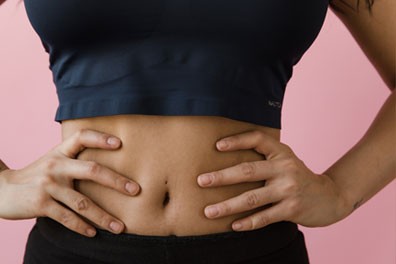Gut Health
FAQ’S
Do I have to be on a restrictive diet forever?
The short answer is no! The diet is usually recommended for 8 weeks and progress is best reviewed with a dietitian so that you can gradually re-introduce foods safely. No one should be on a strict low FODMAP diet forever – in fact, this would be detrimental to your gut microbiota.
What exactly are FODMAPs?
- Fermentable
- Oligosaccharides – Fructans and Galacto-Oligosaccharides (GOS)
- Disaccharides – Lactose
- Monosaccharides – Fructose in excess of glucose
- Polyols – Sorbitol, Mannitol, Maltitol, Xylitol and Isomalt
Examples of foods that contain FODMAPs;
- Fructose: apples, high fructose corn syrup, honey, mango, pear, watermelon
- Fructans: artichoke, beetroot, leek, garlic, onion, wheat
- Lactose: custard, milk, ice cream, yoghurt, cheese
- GOS: Legumes, beans, lentils
- Polyols: apples, apricots, avocado, isomalt, mannitol, mushrooms, prunes, plums
For patients with IBS, the FODMAPs are poorly absorbed in the small intestine and reach the large intestine where they produce gas and have osmotic effects (draw fluid into the bowel). This can lead to symptoms of abdominal cramping, bloating and diarrhoea or constipation.
Many studies have shown that the ingestion of FODMAPs is dose dependent and each individual can tolerate a different dose. For example, one individual may be able to eat small amounts of fructans found in onions and garlic whilst others may be unable to tolerate any! Working with your GP and ideally a specialised dietitian can help you to identify which foods cause the worst symptoms and how much can be tolerated.
Tests for specific intolerances including breath testing is less commonly recommended in recent times due to inconsistent results. What is more ideal is a FODMAP exclusion diet that your dietitian can help you manage. Breath testing can also be used as one way to diagnose SIBO (small intestinal bacterial overgrowth), a condition that can be associated with IBS.
What is the difference between Coeliac Disease and Gluten Intolerance?
Gluten intolerance can have similar symptoms to Coeliac disease, however it doesn’t lead to villous atrophy and subsequently does not cause any of the serious damage and nutrient deficiencies. Therefore, a person with gluten intolerance can eat small amounts of gluten if they want (depending on symptoms), but a person with the Coeliac disease cannot eat any gluten at all. Also called ‘Non-Coeliac gluten sensitivity’ (NCGS) or Non-Coeliac wheat sensitivity’ (NCWS), another wheat component such as fructans (not gluten) could cause these symptoms.
What is most important is not missing Coeliac disease in people who think they are gluten intolerant, so it is crucial to be tested for Coeliac disease before coming off gluten, because it is much harder to test for it after stopping gluten consumption.
IBS – IRRITABLE BOWEL SYNDROME
IBS is a common functional disorder affecting 1 in 7 adults. It is characterised by a group of symptoms related to the gastrointestinal tract, including abdominal cramping, bloating, gas, constipation, diarrhoea and even lethargy. These symptoms vary in severity but typically last at least 3 months for at least 3 days per month.
IBS does not commonly lead to intestinal damage or increase the risk of intestinal cancers like IBD (inflammatory bowel disease), but it can have a significant impact on your daily life.
An IBS diagnosis may be made clinically but is generally a diagnosis of exclusion. Your GP may want to do blood tests and a stool test to rule out other causes. A blood test will help to explore other diagnoses such as coeliac disease, inflammatory bowel disease and nutrient deficiencies. The stool test will help to exclude infection and inflammation. If there is any suggestion of other disease processes from these initial tests, your GP may recommend a gastroscopy and colonoscopy to further evaluate this.
Once the diagnosis of IBS is made, it then becomes about finding the cause, and managing the symptoms. The underlying pathology of IBS is not well understood and a number of factors may trigger it. Commonly it can be triggered by FODMAPs, the different types of sugars found in whole foods. IBS has also been linked to stress and anxiety. The relationship to stress and anxiety requires more research to definitively understand the link, but a discussion with your GP on how to manage anxiety and stress may well help with your IBS.
A food diary is a useful tool to help identify patterns of food consumption with symptoms.
COELIAC DISEASE
Coeliac disease is a condition where the immune system reacts abnormally to gluten. Gluten is a protein found in wheat, barley, oats and rye. When gluten is consumed through the gastrointestinal system, the immune system reacts to the gluten causing small bowel damage in the process.
The small bowel is made up of tiny villi (like plush carpet) that work to absorb nutrients including iron, vitamin D and other key vitamins. Gluten induced damage leads to villous atrophy (the villi become inflamed and flatten). Villous atrophy reduces the surface area of the bowel available for nutrient absorption, causing malabsorption and its symptoms. This can lead to a range of nutrient deficiencies such as iron deficiency and low vitamin D causing conditions such as anaemia and osteoporosis (thin bones).
Coeliac disease affects 1 in 70 Australians. There are genes associated with the disease (HLADQ2/DQ8), but 50% of the population have these genes, so a positive blood test for the genes is not diagnostic. The best test is a blood test looking for coeliac antibodies, and then confirmation with a gastroscopy and biopsy of the lining of the small bowel. However, the person needs to be eating gluten for an accurate diagnosis.
GI symptoms of coeliac disease include:
- Chronic abdominal discomfort,
- Bloating,
- Diarrhea or constipation,
- Nausea and vomiting,
- Weight loss.
It can also lead to non-GI symptoms such as:
- Itchy skin and rashes
- Headaches and fatigue,
- Bone and joint pain,
- Mouth ulcers nutritional deficiencies (low haemoglobin or B12)
People with coeliac disease will have an issue with gluten for the rest of their lives and therefore need to be on a long-term strict gluten free diet. Even tiny amounts of gluten can set off a coeliac reaction. By removing gluten from the diet, the villi of the small bowel are able to heal, regenerate and again absorb nutrients. In theory if gluten free diets are followed, people with coeliac disease should avoid any complications. A dietitian is vital after initial diagnosis to fully understanding dietary management.
Go to Coeliac Australia to find out more about Coeliac disease.
SIBO – SMALL INTESTINAL BOWEL OVERGROWTH
Small intestinal bowel overgrowth is characterised by an abnormal increase in the overall bacterial population in the small intestine. These bacteria do not normally populate the small intestine and subsequently interfere with the normal digestive process causing symptoms of bloating, diarrhoea and in some cases weight loss and malnutrition.
The persistent digestive issues caused by SIBO can lead to poor absorption of fats, carbohydrates and proteins. It can also lead to poor absorption of calcium and vitamin D, that can lead to osteoporosis.
SIBO Symptoms include:
- Loss of appetite
- Abdominal pain
- Nausea
- Bloating
- Feeling of fullness during or after eating
- Diarrhoea
- Weight loss
- Malnutrition
- IBS symptoms
Treatment for SIBO is multidisciplinary, in mild cases diet modification can be enough. A low FODMAP diet for 6-8 weeks in consultation with a dietitian can help eliminate excess bacterial populations in the small intestine. However, it is important to consider the cause of the SIBO and reverse this if possible. Your Gastroenterologist and GP can help you with this. It is also important to correct any nutritional deficiencies. Unfortunately in many cases a cause cannot be found, and where suppression of the SIBO can occur with targeted antibiotics.
INFLAMMATORY BOWEL DISEASE (IBD)
IBD is an umbrella term used to describe disorders causing chronic inflammation of the bowel. The 2 most common disorders are Crohn’s disease and Ulcerative colitis. They commonly present with symptoms of abdominal pain, diarrhoea, rectal bleeding, fatigue and weight loss.
Crohn’s disease is characterised by inflammation of the lining of the digestive tract, which can involve the deeper layers. The inflammation is commonly found at the terminal ileum (end of the small bowel) but can be found anywhere along the digestive tract.
Ulcerative colitis is characterised by inflammation along the superficial lining of the large intestine and rectum (not the small bowel). It does not usually involve the deeper layers like Crohn’s disease.
The exact cause of IBD is unknown, but it does have an autoimmune component and likely relates to the gut bacteria. There is thought that there genes are partly responsible, but an unknown trigger causes the immune system to over activate and attack the cells of the digestive tract (and the gut bacteria). This leads to ongoing inflammation in a relapsing, remitting pattern. There is a higher risk of IBD if a first degree relative has it, but most don’t have a family history.
An IBD diagnosis is made via colonoscopy. Biopsies are taken in areas of inflammation and histology (looking under the microscope at the cells) is used to confirm the exact diagnosis and its severity. Once a diagnosis is made, treatment with a gastroenterologist is required to help heal the intestinal lining and prevent ongoing damage.
Treatment depends on the severity of disease. In very mild cases diet modification can be enough to manage the inflammation. However, in most cases some form of medication is needed in conjunction with diet modification and lifestyle measures.
Diet modification should be discussed with a dietitian who specialises in IBD. Recent studies have shown that avoiding emulsifiers (additives in processed foods) found in packaged foods can help to maintain remission in Crohn’s disease. Exclusion diets (a diet of whole foods with NO emulsifiers) or liquid diets can maintain remission in severe cases under guidance.
IBD can range from very mild to severe and in some cases can become complicated with life threatening disease.
Some of these complications include:
- Skin, eye and joint inflammation
- Increased risk of colon cancer
- Medication side effects
- Primary sclerosing cholangitis
- Bowel obstruction
- Malnutrition Fistulas and anal fissures
- Toxic megacolon (surgery in ulcerative colitis)
Thankfully IBD is now well managed using a multidisciplinary approach and there are a range of different treatments to help. Your gastroenterologist, GP and dietitian can help you navigate a treatment plan that is best for you.
Learn about Bowel Cancer, which is the second most deadly cancer in Australia. Find out what causes it, what its symptoms are, and why screening is so important. For more information, visit Bowel Cancer Awareness.





